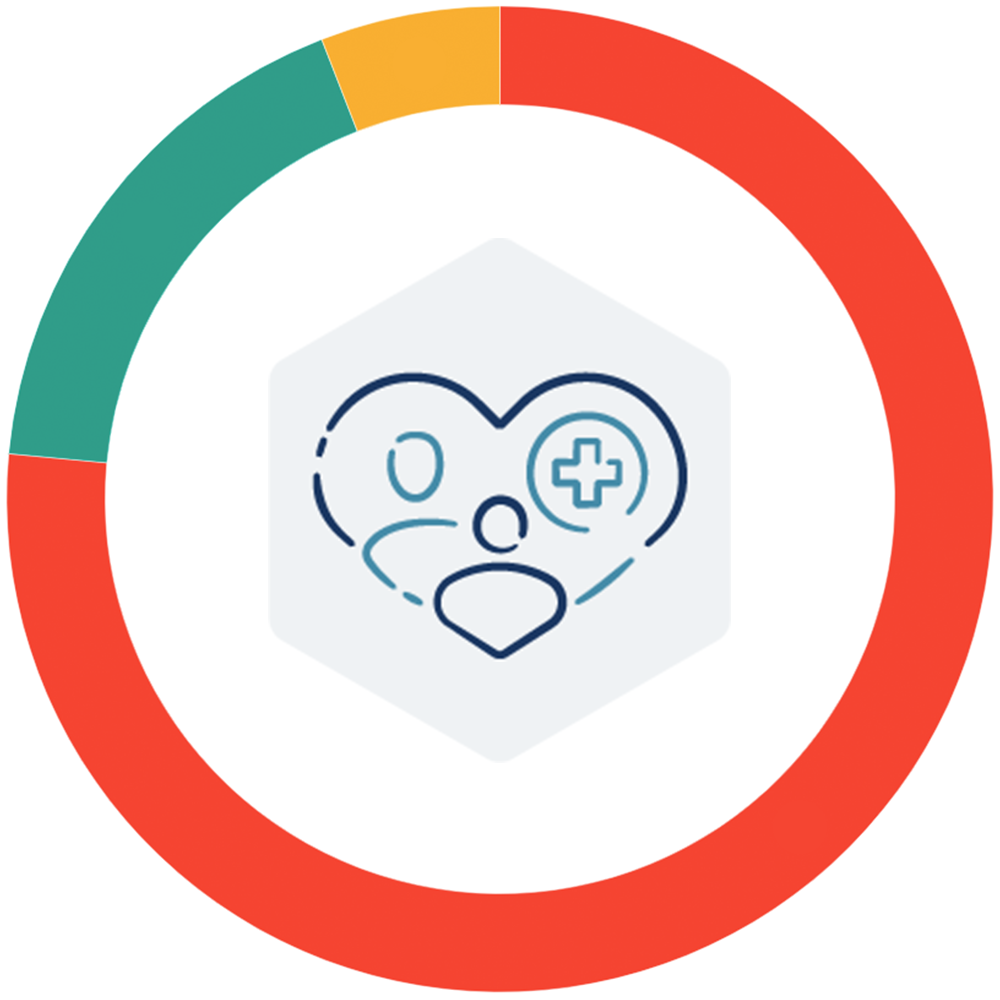Health & Well-Being Supports
Download Health & Well-Being SupportsJob quality and worker well-being are not defined solely by earnings and income. Workplace policies that support the ability to look after oneself and one’s family members are key to a happy, healthy, and productive work environment in the best of times and are absolutely essential in times of a major health crisis, as the COVID-19 pandemic has demonstrated. However, individuals earning low incomes, including early childhood teachers,1A study of Pennsylvania Head Start staff showed that women working with children in Head Start programs are more likely to have poor physical and mental health than women with similar sociodemographic characteristics in the broader population, despite having somewhat greater access to health insurance. See Whitaker, R.C., Becker, B.D., Herman, A.N., & Gooze, R.A. (2013). The Physical and Mental Health of Head Start Staff: The Pennsylvania Head Start Staff Wellness Survey, 2012. Preventing Chronic Disease 2013(10). 10:130171. DOI: http://dx.doi.org/10.5888/pcd10.130171. generally have poorer health2U.S. Department of Health and Human Services, Centers for Disease Control and Prevention, National Center for Health and Statistics (2015). Table 45. Respondent-assessed fair-poor health status, by selected characteristics: United States, selected years 1991-2014. Health, United States, 2015 with Special Feature on Racial and Ethnic Health Disparities. Retrieved from http://www.cdc.gov/nchs/data/hus/2015/045.pdf. and less access to employee benefits such as health insurance3U.S. Department of Health and Human Services, Centers for Disease Control and Prevention, National Center for Health and Statistics (2015). Table 105. No health insurance coverage among persons under age 65, by selected characteristics: United States, selected years 1984-2014. Health, United States, 2015 with Special Feature on Racial and Ethnic Health Disparities. Retrieved from http://www.cdc.gov/nchs/data/hus/2015/105.pdf. and paid leave that contribute to health and well-being.4Bureau of Labor Statistics (2019). Table 6. Selected paid leave benefits: Access, March 2019. Economic News Release. Retrieved from https://www.bls.gov/news.release/ebs2.t06.htm.
“Because of such low pay and high cost of health benefits, other teachers and myself are in constant stress over how to afford basic necessities. This stress is so great it carries over onto our care for the children daily. Working full time in such a physically, mentally, and emotionally demanding job with such great responsibility is exhausting and challenging, to say the least!”
Minnesota5Quote from CSCCE survey of teachers. For more information about the study, see Austin, L.J.E., Whitebook, M., Schlieber, M., & Phillip, G. (2019). Teachers’ Voices: Work Environment Conditions That Impact Teacher Practice and Program Quality – Minnesota. Berkeley, CA: Center for the Study of Child Care Employment, University of California, Berkeley. Retrieved from https://cscce.berkeley.edu/teachers-voices-minnesota-2018/.
Where federal policy falls short, state policy can ensure equitable job quality that leads to better health and well-being among workers and their families through various means, for example by expanding access to affordable health coverage, passing paid sick days legislation, and enacting paid family leave benefits. Such policies reduce the need for workers who are paid low wages to make an impossible choice between their own health — and potentially the health of others in their families and communities — and their livelihood.
Access to health care services is important for worker well-being, but skyrocketing costs make access difficult for many families, especially those with low incomes or those who have lost their jobs. Early educators are especially likely to benefit from expanded Medicaid and other provisions in the Affordable Care Act (ACA). A prior analysis in the 2018 Early Childhood Workforce Index demonstrated the importance of Medicaid for early educators: 30 percent of child care workers and their families and 23 percent of preschool/kindergarten teachers and their families accessed health care through Medicaid or the Children’s Health Insurance Program (CHIP) in 2014-2016.6Whitebook, M., McLean, C., & Austin, L.J.E. (2018). The Workforce Data Deficit. Berkeley, CA: Center for the Study of Child Care Employment, University of California, Berkeley. Retrieved from https://cscce.berkeley.edu/the-workforce-data-deficit/. Many early educators could not access health insurance from their workplaces even before the COVID-19 pandemic struck7Workforce studies in a handful of states suggest that only between 40 to 50 percent of child care centers offer health insurance as an employer benefit, see Child Care Services Association (2016). 2016 Working in Early Care and Education in Iowa. Retrieved from http://www.iowaaeyc.org/2016%20Iowa%20ECE%20Workforce%20Study%20-%20Final.pdf; Roberts, A., Iruka, I., & Sarver, S. (2017). Nebraska Early Childhood Workforce Survey: A Focus on Providers and Teachers. Retrieved from https://buffettinstitute.nebraska.edu/-/media/beci/docs/workforce-survey-report-final.pdf?la=en; Virginia Early Childhood Foundation (2017). The Commonwealth’s Brain Builders: Virginia Early Childhood Workforce Survey 2017. Retrieved from https://www.researchconnections.org/childcare/resources/35857; Whitehead, J., & Ernst, J. (2015). Illinois Salary and Staffing Survey of Licensed Child Care Facilities. Illinois Department of Human Services. Retrieved from https://www.dhs.state.il.us/page.aspx?item=85484. and caused a spike in unemployment and the risk of loss of health insurance coverage, whether one’s own or through a spouse.8Garfield, R., Claxton, G, Damico, A., & Levitt, L. (2020, May 13). Eligibility for ACA Health Coverage Following Job Loss. San Francisco, CA: KFF. Retrieved from https://www.kff.org/coronavirus-covid-19/issue-brief/eligibility-for-aca-health-coverage-following-job-loss/; Bivens, J., & Zipperer, B. (2020, August 26). Health insurance and the COVID-19 shock: What we know so far about health insurance losses and what it means for policy. Washington, D.C.: Economic Policy Institute. Retrieved from https://www.epi.org/publication/health-insurance-and-the-covid-19-shock/.
Even workers with health insurance struggle to make use of health care services due to a lack of paid time off from work when ill or when needing to care for a family member who is ill.9Ben-Ishai, L., & Wang, A. (2017, June 10). Paid Leave Necessary for an Ounce of Prevention. Washington, DC: Center for Law and Social Policy (CLASP). Retrieved from https://www.clasp.org/publications/report/brief/paid-leave-necessary-ounce-prevention-paid-leave-and-access-preventive. Employees with no or very limited paid sick leave may be left with little choice but to come to work while sick, spreading illness to others. Paid sick leave is therefore especially important for early childhood teachers who come in regular contact with young children and their families. Yet, access to employer-based paid sick days remains a rarity in the early childhood field and for many other workers in low-paid occupations across the United States. Nationwide, only about 51 percent of those in the bottom quartile of occupations by average hourly wage had access to paid sick leave in 2019.10Bureau of Labor Statistics (2019). Table 31. Leave benefits: Access, civilian workers,1 March 2019. National Compensation Survey. Retrieved from https://www.bls.gov/ncs/ebs/benefits/2019/ownership/civilian/table31a.pdf.
The United States is one of a handful of countries across the globe that lacks a national paid leave program for parents or at least mothers.11World Bank Group (2015). Women, Business and the Law 2016: Getting to Equal. Washington, DC: International Bank for Reconstruction and Development/The World Bank. DOI: 10.1596/978-1-4648-0677-3. Although the Family and Medical Leave Act (FMLA) entitles eligible employees to up to 12 weeks of job-protected leave to care for a child or family member, this leave is unpaid.12Joshi, P., Baldiga, M., Huber, R., & Acevedo-Garcia, D. (2020, January, 15). Policy Equity Assessment: Family and Medical Leave Act. Waltham, MA: diversitydatakids.org, Institute for Child, Youth and Family Policy, Heller School for Social Policy and Management, Brandeis University. Retrieved from http://www.diversitydatakids.org/research-library/policy-equity-assessment/policy-equity-assessment-family-and-medical-leave-act. Furthermore, it is only available to employees who work at businesses of a certain size (50 employees or more) and therefore excludes broad swathes of the ECE workforce. Only 9 percent of workers in the bottom quartile of occupations by average hourly wage had access to paid family leave through their employers in 2019.13Bureau of Labor Statistics (2019). Table 31. Leave benefits: Access, civilian workers,1 March 2019. National Compensation Survey. Retrieved from https://www.bls.gov/ncs/ebs/benefits/2019/ownership/civilian/table31a.pdf.

Expansion of Paid Sick & Family/Medical Leave as a Result of COVID-19
Because U.S. workers typically are not guaranteed paid sick or family and medical leave, many workers — especially lower-income workers like most early educators — were immediately at risk of substantial loss of income with the onset of the COVID-19 pandemic. While the risk of losing income due to illness or other family care needs is not new for many U.S. families, the severity of the COVID-19 pandemic prompted some limited action by the federal government, which instituted temporary sick and family/medical leave provisions through the Families First Coronavirus Response Act and the Coronavirus Aid, Relief, and Economic Security (CARES) Act. While the provisions were a notable step forward, eligibility was restricted in various ways, with potentially up to three-quarters of American workers ultimately excluded from the law.1Cain Miller, C. & Tankersley, J. (2020). “Paid Leave Law Tries to Help Millions in Crisis. Many Haven’t Heard of It,” May 8. The New York Times. Retrieved from https://www.nytimes.com/2020/05/08/upshot/virus-paid-leave-pandemic.html; CLASP (2020). Paid Sick Days and Paid Leave Provisions in FFCRA and CARES Act, May 6. Retrieved from https://www.clasp.org/publications/fact-sheet/paid-sick-days-and-paid-leave-provisions-ffcra-and-cares-act.
In the meantime, workers in those few states that had already implemented provisions for paid leave were able to benefit immediately from those laws. For example, when the COVID-19 pandemic hit in Rhode Island, the governor’s executive action allowed families to use that leave for school and child care closures. Families were able to benefit from Rhode Island’s paid leave even before the federal Families First Coronavirus Response Act was signed into law.2Boyens, C. (June, 2020). State Paid Family and Medical Leave Programs Helped a Surge of Workers Affected by the COVID-19 Pandemic. Washington, D.C.: Urban Institute, Retrieved from https://www.urban.org/sites/default/files/publication/102325/state-paid-family-and-medical-leave-programs-helped-a-surge-of-workers-affected-by-the-covid-19-pandemic_0.pdf.
Some states, such as Colorado and New York, responded to the crisis by implementing temporary provisions for paid sick days due to the impact of COVID-19.3CLASP (2020, July 1). Paid Sick Leave Laws and Guidance Amended or Expanded Due to COVID-19, July 1. Retrieved from https://www.clasp.org/sites/default/files/publications/2020/12/COVID%20PSD%20Tracker%20Updates%20Nov%2030%202020.pdf. New York also passed a permanent paid sick leave law in April 2020, with eligible employees able to use their sick leave beginning in 2021.4Lovinger, B.E, Wexler, J.A., & Chase, M.E. (2020, April 13). “New York Enacts Statewide Paid Sick Leave Law,” The National Law Review, Vol. X, No. 255, April 13. Western Springs, IL: Vedder Price. Retrieved from https://www.natlawreview.com/article/new-york-enacts-statewide-paid-sick-leave-law.
Overview of State Progress on Health & Well-Being Supports
- Stalled: 39 states
- Edging Forward: 3 states
- Making Headway: 9 states

Since 2018, there has been some state-level progress in efforts to support the health and well-being of workers and families, particularly through expanded access to health care and paid family leave. For health care, five states (Idaho, Missouri, Nebraska, Oklahoma, and Utah) passed new ballot measures since 2018 to expand health coverage eligibility through Medicaid and Virginia passed a bill for expanded Medicaid coverage in the General Assembly. Other notable gains for state-level support of health and well-being include the adoption of paid family leave in three states (Connecticut, Massachusetts, and Oregon), while New York enacted paid sick day legislation. As a result of these policy changes, four states (Connecticut, Massachusetts, New York, Oregon) improved from edging forward in 2018 to making headway in 2020 due to enacting either paid sick days or paid family leave. However, as shown in Figure 3.21, the overall change in health and well-being support offered to families across states between 2018 and 2020 was minimal, as 39 states were stalled in 2018 and remained stalled in 2020.
Key to State Progress on Health & Well-Being Supports
| Health & Well-Being | Values | Maximum Point per Indicator |
|---|---|---|
| State Sick Leave | Yes/No | 4 |
| State Family Leave | Yes/No | 4 |
| Expanded Medicaid | Yes/No | 4 |
| Total | 12 |
| 0-4 points per category | Stalled |
| 5-8 points per category | Edging Forward |
| 9-12 points per category | Making Headway |
Figure 3.21
Map of State Progress on Health & Well-Being Supports, 2020
State Progress on Health & Well-Being Supports, 2018 & 2020
Figure 3.23
State Progress on Health & Well-Being Supports per Indicator, 2018 & 2020
State Progress on Health & Well-Being Supports: Indicators
Indicator 1: Have states expanded Medicaid eligibility under the Affordable Care Act?
Rationale: Improving access to health care services, especially preventive care, was a major focus of the Affordable Care Act. Among other things, the ACA established new subsidies for individuals to purchase health insurance and allowed states to use matching federal funds to expand eligibility for Medicaid to individuals previously ineligible.14This expanded eligibility included but was not limited to single adults and households with a modified adjusted gross income of up to 138% of the federal poverty level. For an individual, 138% of the federal poverty level is equal to $16,394 a year; for a family of four, it is $33,534. Children up to age six and pregnant women qualify under expanded Medicaid with a gross income of up to 160% of the FPL ($38,880 for a family of four). U.S. Centers for Medicare & Medicaid Services (2020). “Eligibility,” Medicaid.gov. Baltimore, MD. Retrieved from https://www.medicaid.gov/medicaid/eligibility/index.html; U.S. Centers for Medicare & Medicaid Services (2020). “Medicaid expansion & what it means for you,” Healthcare.gov. Retrieved from https://www.healthcare.gov/medicaid-chip/medicaid-expansion-and-you/. For details on state-by-state eligibility see U.S. Centers for Medicare & Medicaid Services (2020). “Medicaid, Children’s Health Insurance Program, & Basic Health Program Eligibility Levels.” Retrieved from https://www.medicaid.gov/medicaid/national-medicaid-chip-program-information/medicaid-childrens-health-insurance-program-basic-health-program-eligibility-levels/index.html. However, not all states have been willing to expand eligibility for this critical health service.
Current Status Across States: In 2020, 39 states offer expanded health coverage via Medicaid, with the other states leaving a gap in support for individuals and their families, likely including many early educators and their families, who remain ineligible for Medicaid but cannot afford to purchase health insurance.
Change Over Time: Since 2018, six additional states met this criteria: Idaho, Missouri, Nebraska, Oklahoma, Utah, and Virginia. These states expanded Medicaid through successful ballot initiatives, with the exception of Virginia, where it was approved by the General Assembly. Nebraska,15Enrollment began in Nebraska in August, 2020. Implementation is planned to begin October 1, 2020. See KFF. (2020). Status of State Medicaid Expansion Decisions: Interactive Map, August 17. Retrieved from https://www.kff.org/medicaid/issue-brief/status-of-state-medicaid-expansion-decisions-interactive-map/. Missouri, and Oklahoma adopted ballot measures for expanded Medicaid to be implemented in the future. State leadership in Utah and Nebraska have attempted to roll back full implementation and have added work requirements for Medicaid eligibility. These work requirements were temporarily waived, however, during the COVID-19 pandemic.16Kliff, S. (2020, August 4 updated August 10). How Progressives Flipped the Script on Medicaid Expansion. The New York Times. Retrieved from https://www.nytimes.com/2020/08/04/upshot/missouri-election-medicaid-expansion.html.
Indicator 2: Do states have paid sick leave legislation?
Rationale: Access to employer-based paid sick leave is crucial, as there is no federal legislation guaranteeing paid sick days in the United States. Some states and local communities have taken initiative to ensure that workers have minimum protections for time off when ill or when they need to care for an immediate family member.
Current Status Across States: In 2020, 12 states have paid sick day laws, with most providing up to 40 hours/five days of paid sick time, while some cities and counties have their own provisions.17National Partnership for Women & Families (2020, April). Table: Paid Sick Days – State and District Statutes. Retrieved from https://www.nationalpartnership.org/our-work/resources/economic-justice/paid-sick-days/paid-sick-days-statutes.pdf; National Conference of State Legislatures. (2020, July 21). Table: Paid Sick Leave: Paid Sick Leave Coverage and Benefits, July 21. Retrieved from https://www.ncsl.org/research/labor-and-employment/paid-sick-leave.aspx. However, as with minimum wage legislation, some states maintain exemptions for particular types of workers or for small businesses, either of which may lead to segments of the ECE workforce being excluded from this benefit.18National Partnership for Women & Families (2020, April). Table: Paid Sick Days – State and District Statutes. Retrieved from https://www.nationalpartnership.org/our-work/resources/economic-justice/paid-sick-days/paid-sick-days-statutes.pdf.
Change Over Time: Since 2018, New York is the only additional state to meet this standard.
Indicator 3: Do states have paid family leave legislation?
Rationale: Since most low-income workers cannot afford to take unpaid leave, access to paid family leave is critical: it helps workers maintain economic stability when they need to attend to their own or a family member’s medical and care needs. In the absence of a federal paid family leave program, some states have instituted their own.
Current Status Across States: In 2020, nine states have passed paid family leave legislation.
Change Over Time: Since 2018, three additional states (Connecticut, Massachusetts, Oregon) met this criteria.
TABLE 3.17a
Progress on Health & Well-Being Supports, by State, 2020
TABLE 3.17b
Progress on Health & Well-Being Supports, by Territory, 2020
Continue reading →
Next Chapter: Appendices




